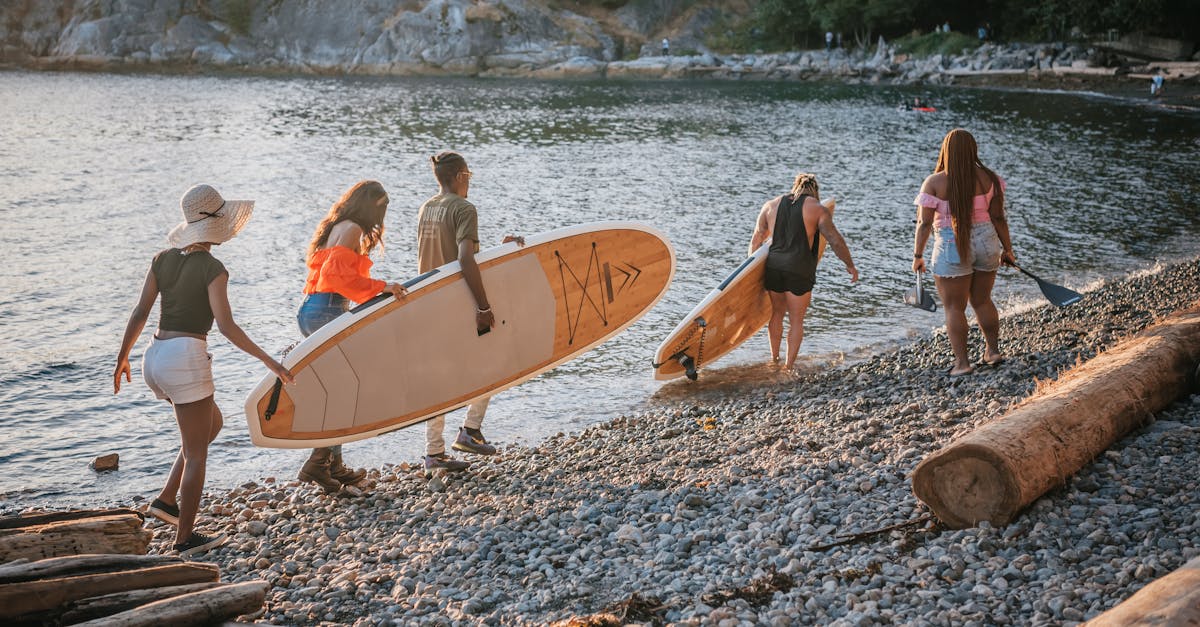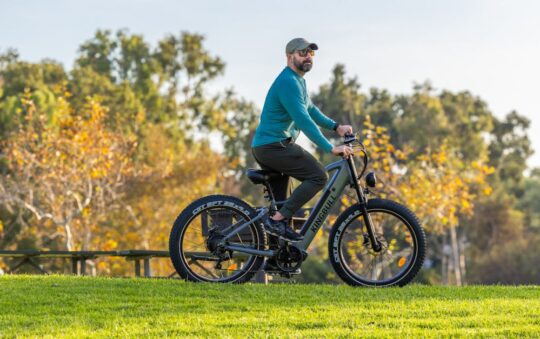<?xml encoding=”UTF-8″>
<?xml encoding=”UTF-8″>
Have you ever felt the urge to glide across a shimmering lake or ride gentle ocean waves without the hassle of bulky gear? I know I have. That’s why portable paddle boards have become my go-to for spontaneous water adventures. Lightweight and easy to carry they open up a world of exploration wherever water calls. In this text I’ll share what makes these boards a game-changer and how they can transform your outdoor experiences.
Features of Portable Paddle Boards
Portable paddle boards pack a lot of convenience and fun into one tidy package. Let’s break down the features that make them stand out and why they’re a great fit for anyone chasing spontaneous water adventures.
Size and Weight
One of the biggest pluses with these paddle boards is how easy they are to handle. Most portable models clock in between 8 and 11 feet long, which strikes a smart balance — long enough for stability but compact enough to carry. The weight usually falls between 15 to 25 pounds. That’s about the same as a bulky backpack or a medium-sized dog, so you can lug these boards without breaking a sweat.
I remember bringing mine on a weekend camping trip, and having a lightweight board made all the difference. I didn’t have to arrange a second vehicle or borrow a friend’s muscles.
Material and Durability
Inflatable paddle boards usually feature materials like military-grade PVC with drop-stitch construction. This means the board stays firm and can resist small hits better than you’d expect from an inflatable. Even though they’re not solid boards, they hold up well against occasional scrapes from rocks or docks.
Expect them to be pretty hardy for regular use. If you’re like me and a bit clumsy, using a paddle leash and landing on sandy banks will help keep your board looking new longer.
Inflation and Deflation Mechanism
Here’s the kicker: inflating and deflating these boards only takes a few minutes. Most come with a double-action pump that fills the board quickly and efficiently. Double-action means you’re pumping air both when you push down and pull up — kind of like a friendly workout.
Deflation is just as straightforward. A large valve lets the air rush out fast, so packing up is as painless as blowing up the board. Plus, many brands now include electric pumps for even easier inflation when you’re not feeling the manual work.
Tip: Always check your psi gauge. Keeping your paddle board at the recommended pressure (usually between 12 and 15 psi) ensures you get the best performance and rigidity.
Design and Shape
Portable paddle boards come in various shapes depending on what you need. Wider and flatter boards offer stability, making them ideal for beginners or yoga on the water. Narrower and longer boards boost speed and tracking for those who want to glide efficiently or cover longer distances.
I tried a wider board first and loved how steady it was for fishing. Then I switched to a sleeker model when I wanted a bit more speed during morning paddles — both felt like customized experiences without extra fuss.
Accessories Included
Most portable paddle boards include essentials like a repair kit, a carry backpack, paddle, and leash. The carry bag is the unsung hero here — it makes hauling your board feel less like a chore and more like a simple part of your gear routine.
Some brands add perks like waterproof phone cases, adjustable paddles, or detachable fins to improve performance on different waters. If you don’t want to hunt for separate parts after purchase, look for bundles with all these extras.
Here’s a quick checklist to keep an eye on when shopping:
- Carry backpack quality
- Adjustable paddle length
- Repair kit completeness
- Sturdy leash included
- Quality fins (removable or fixed)
I found having a clear bundle saved me a lot of time and guesswork in assembling everything I needed.
Here’s a quick performance and specs comparison of common portable paddle board features:
| Feature | Typical Range | Benefit |
|---|---|---|
| Length | 8 – 11 feet | Balance between speed and stability |
| Weight | 15 – 25 pounds | Easy to carry solo |
| Material | Military-grade PVC | Durability & puncture resistance |
| Inflation Pressure | 12 – 15 psi | Board firmness and handling |
| Inflation Time | 5 – 10 minutes | Quick setup |
| Included Accessories | Paddle, leash, pump, repair kit | Ready-to-go convenience |
If you want easy-to-carry boards that don’t skimp on toughness or style these features are what you want to watch for.
Performance and User Experience
Choosing a portable paddle board means balancing how it feels on the water with how easy it is to carry and set up. From my time using different models, I’ve noticed that what makes or breaks the experience isn’t just specs on paper but how the board behaves in real life. Let’s break down the key areas that make portable paddle boards worth every bit of your adventure.
Stability and Balance
One of the first things I look for is how steady the board feels. Stability is crucial especially if you’re new or planning longer sessions like yoga on water. Portable paddle boards typically have a wider base to keep you from wobbling. For example, boards between 30 and 34 inches wide strike a nice balance—wide enough to keep your footing but not so wide it slows you down. If you’re heavier or want to carry gear, choosing a wider model pays off.
Here’s a quick tip: when testing boards, try standing still and shifting your weight from one foot to the other. A beginner-friendly board won’t let you feel like you’re about to tip over. Some brands even add textured surfaces which grip your feet better on wet days.
Maneuverability
Still, having a stable board doesn’t mean you want to feel like you’re dragging a boulder. Maneuverability is all about how well you can turn and weave through calm lakes or mild waves. Shorter boards, around 8 to 9 feet, typically respond faster when you turn the paddle. That makes tight corners easier and feels more playful for casual rides.
But if you’re someone who loves covering longer distances, you might prefer a slightly longer board. These smooth out your paddle strokes but can be a bit less nimble. Personally, I found a 10-foot board with a removable fin gives me the best of both worlds—swift turns when I want them and steady straight lines when I’m cruising.
Speed and Efficiency
On the subject of covering ground, speed comes down to the board’s length and shape. Narrower and longer boards glide on water with less drag—meaning you spend less energy and get more miles in. That said, most portable boards prioritize versatility, so ultra-thin racing shapes aren’t common.
If you’re thinking of calm lake paddles or gentle river trips, efficiency is more about consistent momentum than outright speed. For instance, some of the inflatable portable boards I’ve tested hold their shape really well, so you don’t lose speed to chipmunk puffiness (a fancy name for underinflated boards). Getting your PSI (pressure) right, usually between 12 and 15, helped my boards stay firm and fast without feeling like a rock.
Ease of Setup and Portability
Here’s the kicker: what good is a great board if hauling it takes half the fun away? Inflatable boards shine here. Most pack down into backpacks that fit nicely in your car trunk or even on public transit. Pumping up the board might take 5-10 minutes, but once you get the rhythm (think: steady breathing and consistent strokes on the pump handle), it becomes second nature.
I’ve also come to appreciate when brands toss in extras like easy-clip fins or quick-connect paddles. These details cut setup time and protect you from fumbling with tiny screws in the middle of nowhere. And yes, I’ve had “oops” moments where a paddle slipped out, so having a leash or tether for each piece feels like having a safety net.
Quick Tips to Speed Up Setup and Packing
- Pump in short bursts: Keeps your arm fresh and inflates faster.
- Lay a towel under the board: Protects against rocks or dirt while inflating.
- Practice at home: No one wants a surprise when lakeside with friends waiting.
- Pack all accessories in one bag: One fewer thing to forget (trust me, it happens).
Overall, portable paddle boards offer a fine mix of stability and fun that suits a variety of skill levels and outings. Getting familiar with these main factors helps you pick one that feels just right right out of the bag and on the water.
Pros of Portable Paddle Boards
Portable paddle boards bring a bunch of benefits that make them a favorite for anyone craving quick access to water fun without fuss. Here’s what stands out most to me after testing several models and taking them on numerous trips.
Easy to Carry and Store
One huge win with portable paddle boards is how lightweight and compact they are. Most weigh between 15 to 25 pounds, which means I can easily toss one over my shoulder or tuck it into the trunk of my car. Unlike solid boards that need roof racks or big storage spots, these inflatable options come with backpacks that make hauling them feel almost effortless. On top of that, deflating and folding the board takes just minutes—perfect if you’re spontaneous or tight on space.
Versatility for Different Activities
These boards aren’t just for one thing. Whether I’m looking for a peaceful yoga session on the water, a casual paddle to unwind, or even a bit of fishing, there’s a portable paddle board suited to the task. Many models come with attachment points for gear or extra stability for standing still, giving me that flexibility without switching equipment.
Durable and Weather-Ready
Durability? You’d think an inflatable might be fragile but these boards bounce back like champs. Made from military-grade PVC, they resist punctures and scratches much better than you might expect. I once bumped mine against a rocky shoreline and saw zero damage. That kind of resilience means less worrying and more time enjoying the water.
Quick Setup and Take Down
I love how these boards inflate in about 5 to 10 minutes with a hand pump or electric option. No more waiting around or needing a buddy to hold things steady. Getting on the water fast means more fun and less fiddling. Once done, deflating is just as quick, making the whole process smooth and headache-free.
Stability and Performance for All Levels
Even if you’re just starting out, portable paddle boards offer great stability thanks to wider designs. They help me relax and focus on paddling without constantly worrying about tipping. For more experienced paddlers, many models still provide enough speed and maneuverability to keep things interesting. It’s rare to find a board that balances both beginner-friendly steadiness and agile handling, but many inflatables manage this well.
Value That Fits Budgets
Given the convenience and features, portable paddle boards often come with a price tag that feels reasonable. When I compare what I get—durability, portability, included accessories like paddles and repair kits—the value is solid. You avoid extra costs like roof racks or expensive storage options, which can really add up with traditional boards.
Quick Tips for Choosing Portable Boards:
- Check the weight and packed size if storage and transport are priorities.
- Look for included gear like paddles and backpacks for better savings.
- Consider your main activities—yoga, casual paddling, or fishing—and pick a board with stability or extras tailored to those.
- Make sure the materials are military-grade PVC for toughness.
Owning a portable paddle board means spontaneous trips to the water are never off the table. I can pack light and still get out there whenever the mood strikes.
Cons of Portable Paddle Boards
While I love how portable paddle boards make spontaneous water trips easier, they do come with a few trade-offs worth knowing about.
Less Stiffness Means Less Performance
Inflatable paddle boards, by nature, aren’t as rigid as solid boards. That softer feel can make them a bit less responsive, especially when you want to cruise fast or cut tight turns. If you’ve ever tried to sprint on an inflatable, you’ll notice a little flex that eats up some energy.
Time and Effort to Inflate
Setting up my board means blowing it up first—and even with a hand or electric pump, it takes several minutes. If you’re short on time or don’t want the extra step, this might get annoying. But the good news is, it’s way less hassle than lugging a hard board on your car roof for me.
Limited Load Capacity
Portable boards usually carry less weight compared to their rigid cousins. So, if you like to bring extra gear, a passenger, or even your dog on board, you might feel a bit cramped. I learned this the hard way when I packed my cooler and fishing tackle—my board got a little sluggish.
Durability Requires Caution
Sure, military-grade PVC is tough stuff but inflatables still need care around sharp rocks or boat docks. I’ve heard stories of punctures from careless handling. Carrying the provided repair kit (and knowing how to patch a hole) is almost a must.
Performance Trade-offs for Portability
Because portability is the focus, these boards often lean towards versatility rather than specialized performance. If you want a dedicated race board or one strictly for surfing waves, a portable paddle board might not squeeze out the speed or stability you need.
Bulk When Packed for Travel
Surprisingly, while deflated portable boards pack down, they can still take up considerable backpack or car space. It’s not like stuffing a jacket in your bag—these bags are bulkier and heavier. I keep mine in the trunk but have definitely had to shuffle things around for longer trips.
Quick Tips to Work Around These Cons
- Inflate your board the night before if you’re hitting the water early (I do this sometimes—it really saved me when I forgot my entire afternoon plan).
- Keep load light to maintain good stability and speed.
- Always pack the repair kit and know basic patching techniques.
- Consider your main use—if speed and stiff performance are priorities, look at hybrid models.
- Store boards rolled carefully to avoid creasing or wear spots.
Comparison with Traditional Paddle Boards
When you’re thinking about paddle boards, the portable kind often pop up as the easy-going cousin to traditional solid boards. They each have their perks and quirks. Let me break down the main differences to help you figure out which one fits your lifestyle and paddling style.
Portability and Storage
Portable paddle boards are champs when it comes to packing light and saving space. Since many of them are inflatable, you can deflate them, roll ‘em up, and stash them in a backpack or car trunk without breaking a sweat. This makes them perfect for people like me who don’t have endless garage space or want to jump into spontaneous water trips without a roof rack hassle.
Traditional boards, by contrast, are more rigid and bulky. They take up significant room and usually require racks or special storage spots. They’re great if you have dedicated space or plan on paddling often in the same area.
Quick takeaway:
- Portable boards: Easy to carry, store, and travel with — ideal for city dwellers or weekend warriors.
- Traditional boards: Bulkier, need more storage space, and less convenient for road trips or flights.
Performance Differences
Here’s where the rubber meets the water. Traditional boards usually offer more stiffness, which means better glide and faster speed. If you’re into racing or want sharper turns, the solid build helps give you that edge. They react quicker to your movements, so they tend to feel more responsive.
Portable boards—especially inflatables—tend to have a bit more flex. This means they may feel slightly less efficient when cutting through waves or during high-speed paddling. On the bright side, advances in military-grade PVC and drop-stitch technology have seriously beefed up their rigidity. For casual paddling, yoga on the water, or fishing, they hold their own just fine.
Here’s a simple way to think about it:
- Traditional boards: Better for performance and speed freaks.
- Portable boards: Greater versatility with minor trade-offs in speed or sharp handling.
Price Considerations
If you ask me, portable paddle boards often bring a great bang for your buck. You get board, paddle, pump, and carry bag all bundled usually under $1000. They save money on storage and transport expenses too.
Solid boards can range widely in price. Entry-level options might seem affordable upfront but adding racks, covers, and storage can bump up costs. Specialized high-performance boards quickly become a pricey hobby.
Some quick points if you want to budget smart:
- Portable boards save on extras like racks and storage solutions.
- Traditional boards can cost more upfront and add expenses for accessories.
- Both types have quality options; look for user reviews and warranties.
In my experience, if portability and convenience are priorities, paying modestly more for a solid portable board is a win for everyday use. If you’re more about competitive paddling or consistent speed, heavier investment in a traditional board makes sense.
Alternatives to Portable Paddle Boards
If your paddle board needs don’t quite line up with what portable boards offer, no worries. There are solid options that might suit your style better. Here’s a quick look at some popular alternatives you might want to consider.
Hard Paddle Boards
Hard paddle boards are the classic choice. They’re made from solid materials like fiberglass, epoxy, or carbon fiber layered over a foam core. Compared to portable inflatable boards, hard boards tend to be stiffer and offer better performance on the water.
I’ve noticed that hard boards really shine if you want more speed and stability for long-distance paddling or racing. Because they don’t flex like inflatables, you get more precise control and faster glide. If you’re serious about performance, they might be worth the extra hassle in transport and storage.
A couple things to keep in mind with hard boards:
- Storage needs: They’re bulky and need a proper place at home or on your vehicle. No stuffing one into the closet.
- Transport: Roof racks or special carriers become part of the routine to get them around.
- Durability: They resist dings in normal use but are more prone to cracks if you slam them hard on rocks or concrete.
Still, many users swear by them for weekend adventures where the extra speed and stiffness make a noticeable difference—especially if you’re out on glassy lakes or calm rivers. I remember switching for a summer and loved how much further I could cover on a single paddle stroke.
Hybrid Paddle Boards
Here’s where things get interesting—hybrid paddle boards combine inflatable and hard board features. Think of them as a middle ground offering some portability without sacrificing too much in stiffness or performance.
Hybrids usually have a rigid core covered by an inflatable shell or a foldable design with a firm deck but flexible sides. This gives you lighter weight for easier transport but with a bit more solid feel on the water.
Some benefits I appreciate about hybrids:
- Easier setup: Less hassle than fully inflatable boards.
- Balanced rigidity: Better stability and response than inflatables but not as bulky as hard boards.
- Versatility: Good for casual paddling, fishing, and even light surfing.
Here’s a quick tip if you’re curious about hybrids—check how much of the board is inflatable versus rigid. The more solid core they have the better your balance and speed, but it might cost a bit more or add weight.
In terms of everyday use, hybrids could be that sweet spot for people like me who want the convenience of an inflatable without fully going inflatable. My friend picked one up last summer and was thrilled to commute by car without a roof rack while still enjoying stable rides on the weekends.
Quick Comparison Table:
| Type | Portability | Performance | Durability | Best For |
|---|---|---|---|---|
| Portable Paddle Board (Inflatable) | Lightweight, folds into bag | Flexible, may flex under load | Puncture resistant but needs care | Beginners, travel, casual use |
| Hard Paddle Board | Bulky, needs carriers | Very stiff, fast and precise | Tough but can crack on impacts | Racing, performance paddling |
| Hybrid Paddle Board | Moderate, easier than hard | Balanced rigidity and flexibility | Mix of durability features | Regular paddlers wanting ease |
If you’re wondering whether to stick with a portable paddle board or try these alternatives, think about how you usually get to the water and what you want from your paddling sessions. For some, that extra speed or stability makes all the difference. For others, packing light and quick setup wins every time. Either way, there’s a board out there to fit your vibe (and your vehicle).
Testing and Hands-On Experience
Getting my hands on several portable paddle boards gave me a real feel for what makes a good one stand out in everyday use. Here’s how they shaped up from setup to performance on the water.
Setup Process
Setting up a portable paddle board should feel like you’re getting to the fun part quickly—not wrestling with gear. Inflatable boards typically took me between 5 and 10 minutes to fully inflate using a hand pump included in most packages. That’s about the time it takes to make a cup of coffee (and much more rewarding).
A few quick tips to breeze through setup:
- Lay the board flat and unclamp it from the backpack.
- Use a hand pump or electric inflator if you want to save energy.
- Inflate to the recommended PSI (usually around 15-20) for rigidity.
- Attach fins and secure the leash last to avoid accidental punctures.
I liked boards with wide mouth valves—it made inflation faster and deflation almost as quick. Also, the included backpacks with sturdy straps made carrying the deflated board effortless, even down some uneven paths to the water.
On-Water Performance
Once on the water, stability immediately showed which boards were beginner-friendly and which leaned toward more experienced paddlers. Boards that were wider (around 32 inches or more) felt rock solid and took the wobble out of early tries. Narrower boards? Definitely better for slicing through water faster, but they demanded more balance.
Here’s what stood out during my paddles:
- Control: Boards with fin setups that could be adjusted on the go allowed for tight turns and easier tracking straight without fighting the wind.
- Speed: Lightweight boards glided smoothly but faced some flutter (a slightly shaky feel) in choppy conditions.
- Versatility: Some models handled well both for flat water and small waves, making them great for casual outings or swim breaks (a must for me when the sun’s blazing).
A personal note: carrying snacks and a small cooler was easy on the boards with built-in bungee tie-downs. No need to juggle gear while balancing here.
Durability Test
Durability became clear after a few near-misses with sharp rocks and inevitable beach tales (everyone’s got one, right?). The military-grade PVC on inflatable boards stood up well to scratches and minor abrasions. I tested puncture resistance by lightly dragging one board over pebbled surfaces—no immediate damage and a reassuring toughness overall.
Still, as with most inflatable stuff, careful folding and storage mattered. Leaving a patch kit in the backpack brought peace of mind—especially after a playful session near some jagged driftwood. Repairing a small ding was a quick fix with adhesive patches, which most brands include.
The seams and valves also held steady after repeated inflations, inflation pressure variations, and overnight storage. That’s a big deal because consistent shape means better paddling every time.
Summarizing, if you plan to use your paddle board regularly, treating it like the adventure buddy it is—park spots with care, rinse off saltwater, and don’t overstuff your pack—will keep it in good shape for seasons to come.
Conclusion
Portable paddle boards have truly changed the way I approach water adventures. Their blend of convenience and versatility makes it easy to grab and go without sacrificing too much in performance. While they might not replace solid boards for every scenario, they offer an excellent balance for most paddlers.
Whether you’re a beginner looking for stability or an experienced paddler seeking portability, there’s a board out there that fits your needs. With the right care and a bit of practice, these boards can open up new opportunities for fun and exploration on the water.
Frequently Asked Questions
What are portable paddle boards?
Portable paddle boards are lightweight, typically inflatable boards that are easy to carry and transport. They are designed for spontaneous water activities and usually measure between 8 and 11 feet long, weighing 15 to 25 pounds.
What materials are portable paddle boards made of?
Most portable paddle boards are made from military-grade PVC, which makes them durable, resistant to punctures, and suitable for various water conditions.
How long does it take to set up a portable paddle board?
Setting up a portable paddle board generally takes 5 to 10 minutes, including inflation and unpacking.
Are portable paddle boards stable for beginners?
Yes, wider portable boards offer great stability and balance, making them ideal for beginners and longer paddling sessions.
Can portable paddle boards be used for activities besides paddling?
Absolutely. They are versatile and can be used for yoga, fishing, casual paddling, and other water sports.
What are the main disadvantages of portable paddle boards?
They tend to have less stiffness compared to solid boards, which can impact speed and tight maneuvering. Inflation time and limited load capacity are other common drawbacks.
How do portable paddle boards compare to traditional solid boards?
Portable boards excel in portability and convenience, while traditional boards offer better stiffness and performance, especially for racing or surfing.
What accessories come with portable paddle boards?
Typically, they include a pump for inflation, a carry backpack, a paddle, and a repair kit.
Are inflatable paddle boards durable?
Yes, when properly cared for, inflatable boards made from military-grade PVC are highly durable and resistant to scratches and punctures.
What is a hybrid paddle board?
A hybrid paddle board combines features of both inflatable and hard boards, offering a balance between portability and performance.








